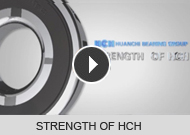- Main Clients and markets
- Customer Service
- Bearing Selection services
- Bearing Handling Service
- Bearing Fitting Service
- Lubrication Service
- Preload
-
Bearing cleanliness

The grease characteristics (viscosity penetration, etc.) and grease quantity can influence the bearing running torque; further to influence the bearing running speed and result in an increase of bearing temperature.
Generally speaking, if the lubricant quantity is increased, the running torque increases, which may result in temperature generation and being speed fluctuation. Also, with the same grease volume, bearing with high viscosity will come out more running torque than those with low viscosity.
Following table lists some frequent problems which are caused by increased running torque.
| Types | Description | Causes | Countermeasures |
|
Temperature Generation |
Bearing temperature is going to be higher and higher. | Churning from several lubricant couplings. Churning type lubricants cause temperature generation because of the shearing effect. |
Reduce the lubricant quantity. Change to a channeling type of lubricant. |
|
Failure to Reach Speed |
Sometimes motors cannot reach the designed nominal speed. | Excessive grease quantity. | Selection of a soft churning type of lubricant. |
|
Excessive Power Consumption |
The motors or engines are higher consuming the power than that was estimated. | The reasons for this are the same as "Failure to Reach Speed" above. Lubricants with high worked penetration can also add to the problem. | Reduce the grease quantity. Change lubricant type. |
|
Excessive Reach Running Current |
The high running current of the motors during operation. | Grease quantity. Worked penetration of lubricant softness level of a churning type of lubricant. |
Selection of a soft churning type of lubricant. Reduce the grease quantity. |
|
Speed Fluctuations |
When bearing is within high rotating condition, speed fluctuations come. | This is caused by grease "slumping" into the pathway of the ball. |
Reduce grease quantity. Use a channeling type grease. Use a much softer type of churning grease. |
● The speed factor n·dm for lubricating greases
The attainable speed factor of lubricating grease depends largely on its base oil type, viscosity, thickener type, and of course the bearing type used. Under high-speed bearing operating conditions it is important to achieve a constant oil supply.
| Grease types |
Base oil viscosity at approx, 40℃ [ mm2/s ] |
Speed factor n·dm |
| Mineral / lithium / MoS2 | 1000 to 1500 | 50,000 |
| Mineral / lithium complex | 400 to 500 | 200,000 |
| Mineral / lithium / MoS2 | 150 to 200 | 400,000 |
| Ester / polyurea | 70 to 100 | 700,000 |
| Ester / lithium complex | 15 to 30 | 1,600,000 |
| Ester / polyurea | 15 to 30 | 2,000,000 |




